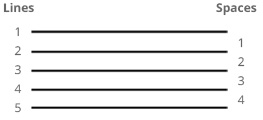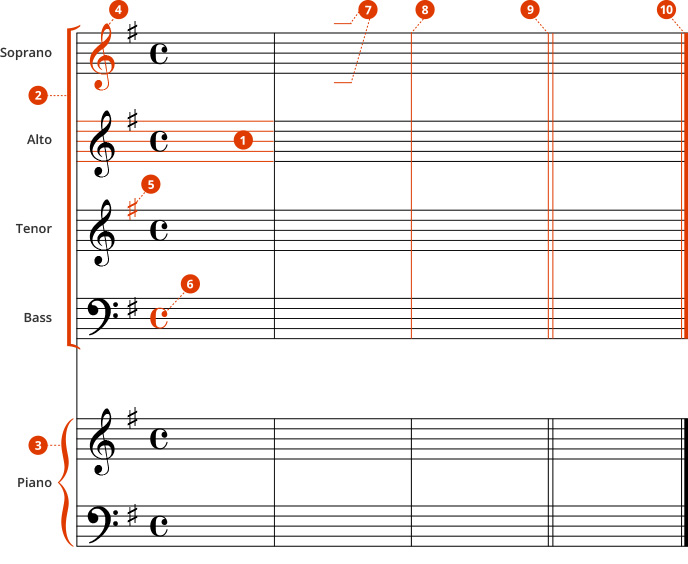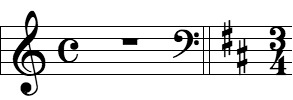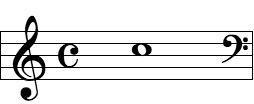Components of the Staff
The staff (or stave) is a set of five, equidistant, horizontal lines joined together by barlines. The staff is used to clearly communicate musical notation. Note symbols, dynamics, and other performance directions are placed within above and below the staff. More than one staff can be grouped with a bracket or a brace to create a system. The bracket typically groups independent parts to form a system. In the example below, the voice parts (soprano, alto, tenor, and bass) are connected with the bracket to create visual grouping of the voice parts. They are independent because each of the voices only needs their part to perform the music. The brace typically groups dependent parts to form a system. In the example below, the piano parts are connected with a brace or curved bracket, to create the visual grouping of the piano parts. The parts are dependent because both treble clef and bass clef staves are necessary to perform the music on the piano.
The staff has several components that are commonly found in every composition. When discussing the staff, numbers are used to identify the lines and spaces. The numbers start from the bottom for both lines and spaces. When referring to lines and spaces above or below the staff, count from the first space above (or below) the staff or the first line above (or below) the staff.

The basic components of the staff are listed below and shown in the example below. |
||
1 |
staff (or stave) | The staff (or stave) provides a framework to indicate all aspects of music (i.e. pitch, duration, dynamics, etc.) |
2 |
bracket | The bracket provides a visual connection between independent parts into a system. |
3 |
brace | The brace provides a visual connection between dependent parts (i.e. two piano staves) into a system. |
4 |
clef | The clef indicates the specific pitches represented by the vertical position of notes on the staff. |
5 |
key signature | The key signature indicates the tonality of the composition. |
6 |
time signature | The time signature indicates the underlying rhythmic patterns that will be used in the composition. |
7 |
ledger lines | The ledger lines provides a method to indicate pitches above and below the . |
8 |
barline | The barline separates rhythmic note groupings based on the time signature. |
9 |
double barline | The double barline is used to indicate a change in the composition such as a change of key or change of meter. It also can be used as a convenient location for an ensemble to start in a rehearsal setting. |
10 |
final barline | The final barline indicates the end of the composition (or in some cases a movement of a composition). |

More About the Staff
|
A musical notation provided by the composer (or editor) to make it easier for the performer to read and interpret complex or often confusing music notation. This notation will indicate to the performer that there will be a change in one or more aspects of the composition or that a temporary change that has taken place is no longer in effect. Courtesy Signs can show changes in the clef, the key signature, the time signature, or accidentals. Courtesy Signs are often provided so the performer can keep up with quick changes in the composition or be reminded of the current clef, key or time signatures in new staves or page turns. Their name is appropriate, because they are provided as a courtesy for the performer. Many courtesy signs will appear at the end of a measure or staff to make the performer aware of changes to the next measure or staff, however, courtesy accidentals are shown at any point in a composition where a note has been changed. Clefs, key signature and time signature changes will be shown in a specific order and are placed after the last barline of the staff. The courtesy clef is always placed before the last barline of the staff. Courtesy accidentals appear in front of notes that are reverting back to their original pitch from an accidental in a previous measure and are often enclosed in parentheses marks. |
||
|
A musical notation provided by the composer (or editor) to warn the performer that the clef will be changing on the next staff. This notation is always placed before the last barline on a staff where the new clef begins immediately on the next staff. |
||
|
A musical notation provided by the composer (or editor) to warn the performer that the key signature will be changing on the next staff. This notation is always placed after the last barline on a staff when a new key signature begins immediately on the following staff. In this situation, the end of the staff or system would be open with no barline and a double bar should be placed before the courtesy key signature at the end of the staff or system. | ||
|
A musical notation provided by the composer (or editor) to warn the performer that the time signature will be changing on the next staff. This notation is always placed after the last barline on a staff when a new time signature begins on the following staff. In this situation, the end of the staff or system would be open with no barline and a double bar should be placed before the courtesy time signature at the end of the staff or system. |





